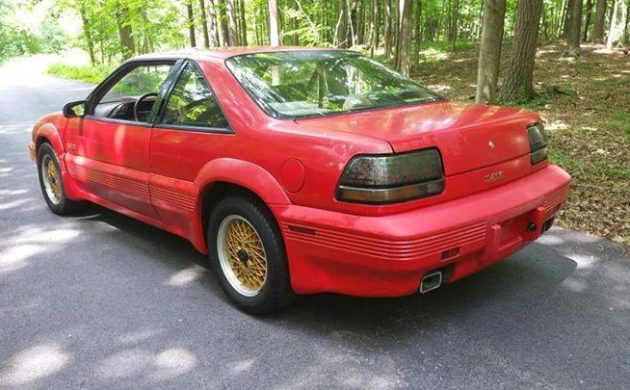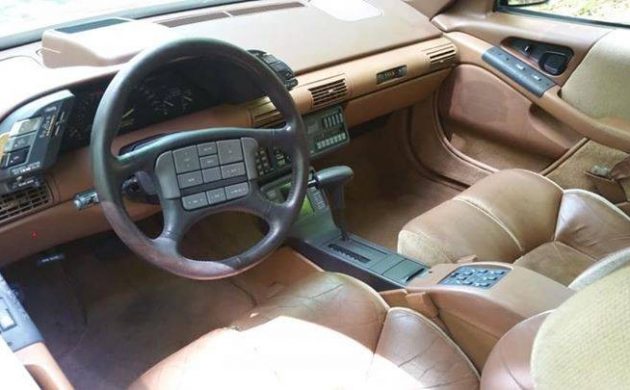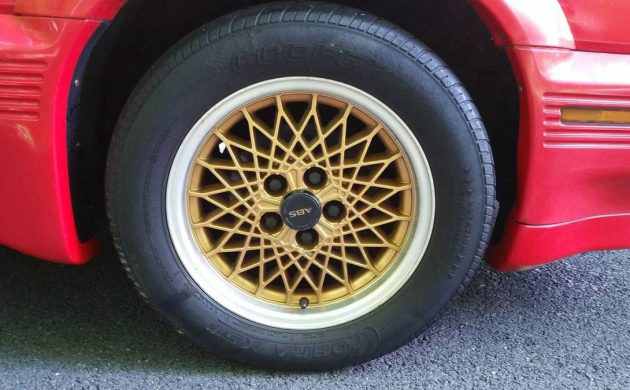“We build excitement!” Pontiac ads crowed in the 1980s and ’90s, and while many elements of Pontiac’s late-20th century conception of excitement may not have aged super well, there were at least some credible performance cars involved. One of the rarest of these was the ASC/McLaren Grand Prix Turbo coupe, built in limited numbers in 1989 and 1990 only; Road & Track dubbed it “the musclecar…for the Nineties” in an April, 1989 road test. This first-year example has been off the road for many years, but comes with an extra engine and transmission—and an asking price of just $2,000. Find it here on craigslist out of Orange County, New York; many thanks to reader Matt G. for the find!
As the name suggests, Pontiac worked with two outside firms to build this hi-po Grand Prix. The American Sunroof Corporation (ASC) was responsible for the be-flared plastic lower-body cladding and bumpers, a styling trope that Pontiac would run with and that would come to embody everything wrong with late-stage Pontiac “excitement.” On the happier side, McLaren Engineering—a Livonia, Michigan company that was founded by Bruce McLaren, but which is entirely separate from his British namesake company that builds Sennas and such—stroked GM’s corporate 3.1-liter V6 and added an intercooled Garrett T25 turbocharger to give performance to back up the exuberant looks.
On the whole, this GP looks fairly clean, but the 3.1 hasn’t seen driver duty in roughly a decade. The 96,000-mile mill does run, and has a new fuel pump and tank, but the seller notes that new rear brake lines are needed before the car is drivable, and mentions a need for a new coil pack and new tires as well. The turbo Grand Prix was automatic-only—R&T noted, “At the present time, there is no GM front-drive manual gearbox that will handle the torque of the turbo 3.1″—but a later 3.4-liter V6 and Getrag 284 five-speed that the seller planned to swap into this car are included in the sale. The 284 is a fairly unusual unit, used by GM only in W-body cars with the 3.4, and apparently very difficult to find spare parts for; I don’t know whether it could be bolted to the turbo 3.1, or if using it would require swapping in the larger motor as well—or whether it’s worth the hassle either way.
Regardless of what the buyer of this Pontiac performance bargain plans to do underhood, things look fairly tidy—if predictably plasticky—in the caramel-colored leather interior. In addition to the usual Pontiac profusion of buttons and the Grand Prix’s unusual glovebox combination lock, the ASC/McLaren sported a super gee-whiz head-up display. No word on whether it still works, but the rest of the interior, including the heavily sculpted, turbo-exclusive rear buckets seems intact and presentable.
So some of Pontiac’s styling excesses are on full display, but there really is credible performance machinery here, too. Although GM would continue to slap these “ABS” badges on cars well past the point that it conferred any bragging rights, the high-powered stoppers were still a strong selling point in ’89. The turbo’s performance compared favorably to the Trans Am GTA and the similarly new Thunderbird Super Coupe, and Road & Track reported minimal (if not nonexistent) torque steer, excellent skidpad grip, and a broad torque curve with nary a hint of turbo lag. Sounds like some decent excitement to me—would you put in the wrench time this Grand Prix needs to see what excitement it has to offer?







Can’t go wrong with this at $2k!
Wish i had some remote excuse for buying it & a place to put it.
Loved these when they came out, very rare to see one in the wild.
Great piece of auto history worth saving.
Fun fact about the Getrag 284 that I couldn’t quite squeeze in: one of its more notable non-GM applications was the Chrysler TC by Maserati!
Better round up a few parts cars if planning to own as a keeper. Cash for clunkers as well as high scrap prices killed off many of it’s brethren.
One owner car as this seller did not title the vehicle. So a 10 year old title in someone else’s name? Too bad ,that’s too much of a posible cluster in my state. Cool car though
The thing about these and you can see it in the linked articles for 2 other ones right in this article is that the difference between and “okay” one of these and a really nice one is about $2500-3000? If you can afford 2K can you afford 5K? Because that would get you pretty much ready to drive pristine one right now.
I love these, I had one of these in the GTP version with this color scheme, they were pretty cool, the interior always got “wow” comments even when it was still a fairly new car, they had this cool “future-tech concept car” look to them.
Though it would be tough to choose between one of these and the later Twin-Cam 3.4 ones, true that the DOHC 3.4 doesn’t have a great rep, though the one I had was pretty good, timing belt replacements are required at every 60K vs this car which doesn’t need that, but the 3.1 Turbo is rarer and I imagine harder to find parts for compared to the 3.4 DOHC engine which was made from 1991-1996 in Pontiac, Olds and Chevy W-cars.
I agree. I really like these, and getting one is tempting, but since they’re so cheap in near-mint condition (e.g. there’s one on Hemmings right now with 27k miles for $9.5k or best offer, and it’s probably overpriced), there seems to be little reason to get one with a lot of needs.
But if this one truly only needs brake lines and a good clean up, it could be a great deal. I’d want to inspect it carefully first though. And also bear in mind that GM likes to discontinue parts after 10 years or so, so it may be difficult to get even basic things.
In addition, 3 1997 Olds Cutlass Supreme’s were built with the LQ1 motor.
In 1988 I was the *only* journalist who was allowed to drive the prototype version of this car at a Wisconsin “Short Leads” preview, possibly because I had scared the h*ll out of a GM engineer in a Fiero half an hour earlier. What impressed me was the European feel of the interior and the controls. The engine management system was not yet properly sorted, and I recall a serious power flat spot in the upper RPM range.
Still, the color scheme was one of the “in your eye beautiful/aggressive” sorts, with the red paint, saddle leather, and gold accents. Many of the styling cues and tech features would filter down a couple of years into other bodies, notably the Bonneville SSE and SSEi versions.
Could be a nice car, not many left!
Though really the SSE actually pre-dates these, coming out in 1988, they had the articulating seats and the button filled steering wheel too, actually lots of what the Turbo GP had was already on the Grand Prix SE in 1988, minus the steering wheel radio controls, which came out on the GP in 1989, the Turbo GP added the first HUD application, shared with the Cutlass Supreme.
Very recently two you tubers have bought these.
I understand they are rare but there seems to be a lot of them for sale.
The weak spot seems to be the anti-lock brake system that is not repairable.
If anybody is interested in this car, be aware you will probably have to change it over to a normal master cylinder and booster.
Yup. That’s not your imagination. Some people began salting new performance cars away starting in the late 1980s because of the explosion in value of 1960s and early 1970s muscle cars. Many figured that the same thing would happen again and that cars like this “musclecar…for the Nineties” would be worth $50k by 2010.
Of course, that never happened. Gen Xers and Millennials just did not get into cars like the Baby Boomers did and their overall incomes lagged behind, which limited their discretion to bid up the cars of their youth. But the positive result is that there are a lot of 1980s and early 1990s muscle cars out there with super low mileage that can be had for not a lot of money.
You can also attribute a lack of interest in these cars due to the fact that there were no “bad times” after these came out, cars just got better and faster, unlike from the 60 to the late 70’s early 80’s for example.
People collected 396 Chevelles when all you could buy was a Celebrity with a 2.8, but a 200hp Grand Prix isn’t as interesting when there are 300hp 4 bangers.
Ralph, that is a good point.
The Craiglist ad mentioned a Getrag manual tranny as part of the package. I had a 1992 Olds Cutlass Supreme that went thru two of these transmissions in less than 60,000 miles. That car also needed a replacement 3.4 short block, a CPU, a clutch slave cylinder, a starter motor, an air conditioner compressor and several other items before I got rid of it. This led me to the conclusion that my next GM vehicle would be a snowmobile…..because there would be blizzards in hell before I made another GM purchase!!
This isn’t the one from Hoovies garage is it?
In the eighties it should have been “We Build Excrement” but truth in advertising wasn’t a big thing then.
on mine i set the anti-lock brakes to were it sent pressure to all 4 wheels, see in default mode it only sends it to the front wheels and then you disconect the power to the anti lock servo so it can’t cycle to default mode and take the bulb out of the dash. a tech guy for gm told me that i could spend a thousand dollars on the brake sys. and not fix it. that is alot easier than converting all that stuff. he told me he fixed alot of them that way. looked all stock but in fact the anti-lock was not powered up. the owner never noed the diferance and would say how much better the brakes worked
GM did build 3 Cutlass Supremes in 1997 with the LQ1 3.4 DOHC 24 Valve motor. Yes, 1996 was the last year for this motor option in 1996.
For people thinking this brake system isn’t repairable, apparently have not done your homework. I owned a red one 20 yrs ago and currently own 2 (1 red and 1 black) 1990s. Both had just under 100k miles and one needed a new accumulator and the other needed everything in the brake system.. GM sold many of these systems to Lotus and were used for a number of years under the name delco morraine IIIa since the lower bracket that contained the pump, pressure switch, etc was a seperate unit located inside the dash behind the instrument cluster. Otherwise one and the same. Land rover and also the Turbo thunderbird uses basically the same accumulator ball and with little research you’ll find that lotus has an aftermarket pressure switch which requires a banjo fitting and 2 separate switches (1 for high/low and 1 for indicator light) also found my gaskets and seals there and plenty of used parts also circulating the lotus and tgp forums.
Well researched and valid points, Kev.
Good post.